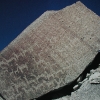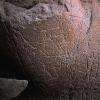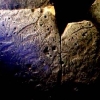Petroglyphs, also known as engravings, are drawings etched onto the surface of rocky outcrops or isolated boulders to produce carved shapes in the rock. Petroglyph designs are made using a tool that is harder than the rock itself, usually a cutting or striking instrument that can break through the oxidized patina (outer layer) of the stone. When this film is removed, the carver exposes to view the lighter interior color of the rock, producing a drawing by contrast. Relief images have also been found that were made by removing the patina around the desired shape.
Modern experiments with similar results have shown that petroglyphs were produced using five main techniques, singly or in combination: Incising, which is the cutting or breaking of the stone medium by the unidirectional movement of an artifact, the cutting edge of which moves parallel to the direction of use image 3. Scraping, which involves abrasion of the rock in a bi-directional movement using an artifact whose sharp edge moves perpendicular to the direction of use image 2. Drilling, in which a sharp instrument is gradually inserted into the rock by rotating it clockwise and counterclockwise image 4. Indirect percussion, in which one instrument is used as a hammer and another as a chisel imagen 1. Lastly, hammering, in which an artifact is used to strike the rock face directly.








































